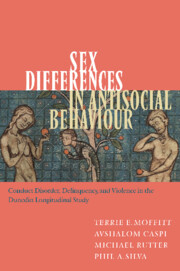 Sex Differences in Antisocial Behaviour
Sex Differences in Antisocial Behaviour Published online by Cambridge University Press: 22 September 2009
In this chapter we address a debate in the field about the best way to diagnose conduct disorder among females. Should the sexes be diagnosed using the same criteria, as is now done? Or should the diagnostic criteria for females be relaxed to a milder standard than the criteria for males?
Leading one side of this debate, Zoccolillo (1993) has argued for genderspecific criteria, recommending that fewer symptoms should be required for diagnosing girls than boys. This argument is based on the clinical observation that girls with levels of symptoms that would be considered mild for a boy (and below DSM's diagnostic threshold) nevertheless often experience clinically significant problems in their health and social functioning. In one study that evaluated the recommendation to relax the diagnostic criterion, doing so predictably raised the prevalence rate of conduct disorder for a sample of 10-year-old girls, but also netted more of the sample's girls who had a history of early-onset pervasive behaviour problems in kindergarten (Zoccolillo, Tremblay, and Vitaro, 1996). This result suggested that relaxing the diagnostic criteria for girls may augment sensitivity of the conduct-disorder diagnosis to consequential female cases. However, no boys were studied, so we do not know whether relaxed criteria might have benefited measurement validity for both sexes at age 10.
On the other side of this debate, Zahn-Waxler (1993) has argued that we should reject the recommendation for relaxing conduct-disorder diagnostic criteria for girls.
To save this book to your Kindle, first ensure [email protected] is added to your Approved Personal Document E-mail List under your Personal Document Settings on the Manage Your Content and Devices page of your Amazon account. Then enter the ‘name’ part of your Kindle email address below. Find out more about saving to your Kindle.
Note you can select to save to either the @free.kindle.com or @kindle.com variations. ‘@free.kindle.com’ emails are free but can only be saved to your device when it is connected to wi-fi. ‘@kindle.com’ emails can be delivered even when you are not connected to wi-fi, but note that service fees apply.
Find out more about the Kindle Personal Document Service.
To save content items to your account, please confirm that you agree to abide by our usage policies. If this is the first time you use this feature, you will be asked to authorise Cambridge Core to connect with your account. Find out more about saving content to Dropbox.
To save content items to your account, please confirm that you agree to abide by our usage policies. If this is the first time you use this feature, you will be asked to authorise Cambridge Core to connect with your account. Find out more about saving content to Google Drive.